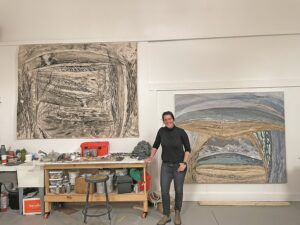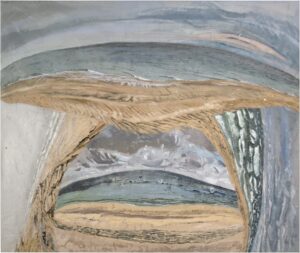Elizabeth Flood’s tempestuous paintings and ink drawings capture the striations of history, violence, extraction, and sublimity that accumulate in a landscape over time.
So, it makes sense that after bearing artistic witness to the Province Lands and the Atlantic Ocean as a Fine Arts Work Center fellow last year, Flood would extend her testimony through a second residency.

“The longer you pay attention in one spot, the more things start to emerge,” Flood says.
The multiple meanings and resonances of a place fascinate Flood. Before getting an M.F.A. in painting at Boston University in 2019, she majored in history and religious studies (with a minor in studio art) at the University of Virginia in her home state. “I don’t think it’s a coincidence I’m making this work,” she says. She has painted abandoned industrial quarries in Quincy and Civil War battlefields in Gettysburg, creating works that vibrate with the emotional and historical weight of their subjects.
Provincetown, and particularly the starkness and history of the Province Lands, have proved generative for Flood’s plein-air painting practice. Last year, she began lugging paints, canvases, and easels in her truck out to remote spots on the dunes, enduring the elements as she depicted them. Mixing grit and pumice into the paints lent a heavy physicality to her surfaces, making the act of painting “feel more like literally digging into the earth,” Flood says.
She learned she had received a second FAWC fellowship in mid-April and spent the summer working teaching painting in various locales in Massachusetts. “It was amazing to know I was coming back here in the fall,” she says.
This time around, Flood’s material approach has remained largely the same, save for some “micro-adjustments,” such as pre-priming her canvases at the studio and cutting stretcher bars the night before.
“It’s a tricky balance of not forgetting what you know, but also being willing to adapt,” she says.
Flood started painting where she left off at the same spot along Race Point Beach, and the fruits of her labors across two winters in Provincetown share much of their DNA. A five-panel painting from her second residency titled Atlantic Ocean, Race Point — currently on display at PAAM — shares the scale, horizontality, and gestural verisimilitude of her previous work, which “communicate a holistic experience of the landscape,” as Abraham Storer wrote last year in the Independent. She is now painting another multi-panel piece at the peak of the dunes off Snail Road.

But in other works, Flood’s experiments with perspective have produced a new kind of environmental and existential turbulence on the canvas. While her previous five-panel panoramas depict landscapes from a consistent location, Flood’s new painting Turbulence (Race Point) destabilizes the viewer by employing different sight lines on the same canvas, which revolve around each other like undulating tiles in a mosaic. Painted at the actual location at Race Point where the ocean skirts around the curving land as the lighthouse keeps watch, the work requires a rotating gaze to unfurl its vantage points.
“The curve out there is so dramatic and disorienting,” Flood says. “The shapes were informed by the shape of the land.”
Up close, the painting clearly depicts four distinct horizons: directly west toward Plymouth on the top of the canvas, north up Race Point Beach on the right, south toward Herring Cove on the left, and ultimately west again in the oculus-like bottom middle region, re-animated by whale activity. “It felt like a zooming compression of the top vantage point, like using binoculars or a telescope,” Flood says.
Step back, and the painting acquires a more representational and surreal effect than Flood’s multi-panel pieces. The endless-seeming curving horizons resolve in the shape of a whale’s tail, rising from the figures in the distance — or maybe it’s a gliding sting ray, carrying a past image of Race Point above a future one. Flood also points out the shape of a ship’s window.
A companion large-format ink drawing, all reactive lines and quick strokes, shares the same invigorating confoundment of landscape conventions.
For the painting, Flood used a single unstretched piece of primed linen that she clamped down and worked on one segment at a time. But her signature gritty paints, which make for a more brittle surface, caused cracking on the painted linen when she rolled it up to transport it. She is still figuring out how to fully stretch the painting for hanging.
“I really had to be rough on this painting and allow the elements to dictate what happens to it,” she says. “It felt like an exciting direction.”
Flood hopes the result is a painting that communicates the destabilizing nature of the landscape. “The disorientation that happens, the turbulence, the churning, feels like the perfect metaphor for not only the landscape but an internal life,” she says. “The landscape is a conduit through which we process emotions — violence and joy and sadness and grief. It’s the best teacher around.”
Fellow Friday
The event: A presentation of new work by visual art fellows Elizabeth Flood and Sichong Xie and writing fellows John Murillo and Christa Romanosky
The time: Friday, April 7, 5 to 8 p.m.
The place: Fine Arts Work Center, 24 Pearl St., Provincetown
The cost: Free; see fawc.org for information



